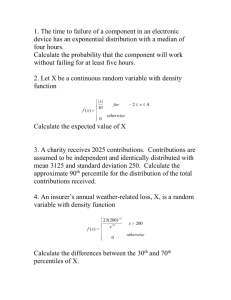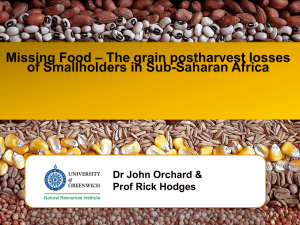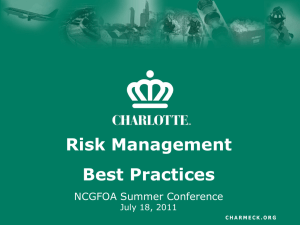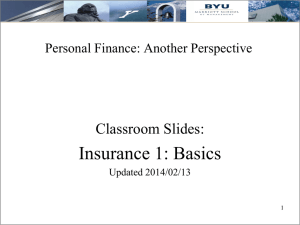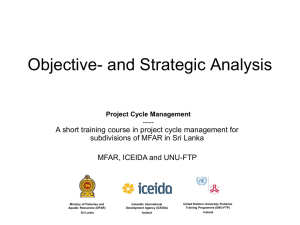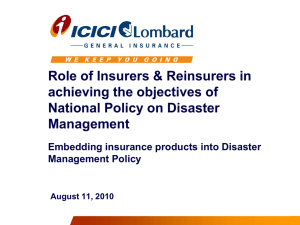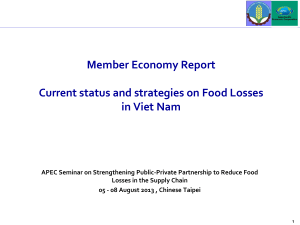energy-041114 - Insurance Information Institute
advertisement
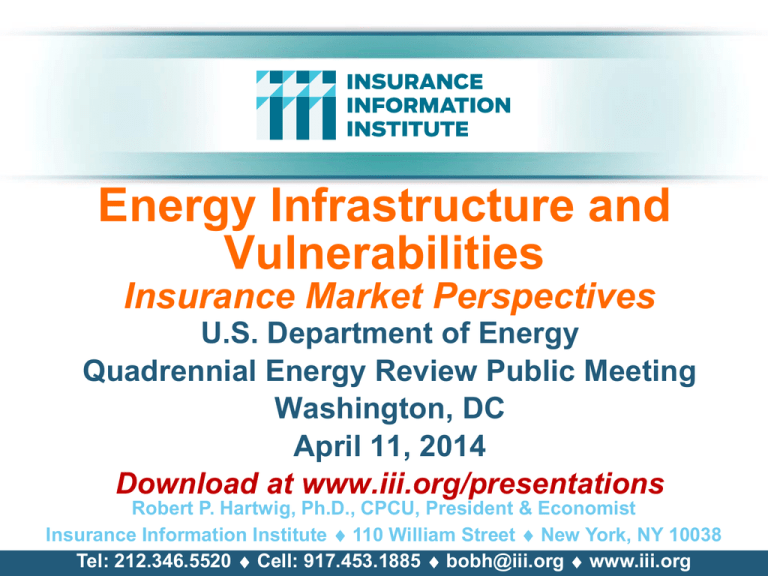
Energy Infrastructure and Vulnerabilities Insurance Market Perspectives U.S. Department of Energy Quadrennial Energy Review Public Meeting Washington, DC April 11, 2014 Download at www.iii.org/presentations Robert P. Hartwig, Ph.D., CPCU, President & Economist Insurance Information Institute 110 William Street New York, NY 10038 Tel: 212.346.5520 Cell: 917.453.1885 bobh@iii.org www.iii.org Energy Is a Very Large and Very Challenging Business for Insurers Worldwide Energy is One of the Few Major Markets/Industries With Clear Long-Term Growth Trends 2 Energy Insurance Market Summary Energy is Among the Insurance Industry’s Largest Industry Sectors Insurers Have Extensive Experience Offering Comprehensive Solutions Across the Entire Spectrum of Energy Industry Property and Liability Exposures Extraction (on/offshore) Refining and Storage Transportation (marine, rail, truck) Generation (Electricity) Renewables Workers Compensation Management Liability (D&O) 3 Energy Insurance: Market Summary (cont’d) Multi-Billion Dollar Limits Are Available in Most Segments Property and liability exposures Risks are rewarded for superior experience Results Can Be Volatile Insurers Work Closely With Client Risk Managers Price of Coverage is Both Event Driven and Cyclical Market is Truly Global Substantial share of underwriting capacity originates abroad History of Working Closely to Reduce Loss, Enhance Resilience Major losses stimulate innovative risk management Price (premium/rate) is a powerful signal about risk; Motivates 4 World Primary Energy Consumption, 1990-2040P Quadrillion BTUs 900 800 700 600 Growth in worldwide energy consumption will create more risk and vulnerabilities (natural and manmade); Innovations in risk management and insurance are needed. 729.2 629.8 523.9 500 400 819.6 406.0 354.8 Between 2010 and 2040, energy consumption in projected to increase by 56.4% worldwide 300 200 100 0 1990 2000 2010 2020P 2030P Source: Energy Information Administration, 2013 International Energy Outlook, Insurance Information Institute. 2040P Cumulative Projected Investment in Global Energy Infrastructure, 2011-2035 ($ Trill.) Projected energy infrastructure investment through 2035 total $38 trillion; Implies substantial incurrence of risk. Natural Gas, $9.5 , 25% Coal, $1.1 , 3% Biofuels, $0.3 , 1% Power, $16.9 , 44% Oil, $10.1 , 27% Source: International Energy Agency, World Energy Outlook 2011. US Electric Power Generation by Fuel Source, 2010-2035F (Billions of Kilowatt Hours) Coal Petroleum Natural Gas Nuclear Renewable Other 4,118 4,279 4,427 594 630 914 887 5,000 4,500 4,000 3,500 3,000 3,806 390 807 3,796 3,937 504 544 579 887 917 1,074 874 983 903 882 26 27 27 25 26 1,531 1,604 1,710 1,757 1,803 2015 2020 2025 2030 2035 830 2,500 2,000 776 32 1,500 1,000 1,799 500 0 2010 Demand for Electricity Is Expected to Grow at a 0.6% Annual Rate Through 2035. Renewables and Natural Gas Will Account for an Increasing Share of Fuel Source Source: US Energy Information Administration, Annual Energy Outlook 2012, Appendix A7. 7 The Past Few Years Have Not Been Kind to Insurers or Utilities Hurricane Irene: Aug. 27-29, 2011 Insured Losses: $4.3 Billion Customers w/o Power: 5 Million “Snowtober” Blizzard: Oct. 29, 2011 Insured Losses: ~$1 Billion Customers w/o Power: 2.7 Million Derecho: June 29, 2012 Insured Losses: ~$1+ Billion Customers w/o Power: 3.7 Million Source: Insurance Information Institute research. Superstorm Sandy: Oct. 29-30, 2012 Insured Losses: $18.8 Billion Customers w/o Power: 8.1 Million 8 U.S. Insured Catastrophe Losses $73.4 ($ Billions, $ 2012) $33.6 $35.0 $12.8 $7.5 $10.5 $29.2 $33.7 $16.3 $7.6 $6.1 $11.6 $14.3 $3.8 $11.0 $12.6 $8.8 $10 $8.0 $20 $4.8 $30 $14.0 $40 $26.4 $37.8 $50 $34.7 $60 $14.4 $70 2012 was the third most expensive year ever for insured CAT losses $11.5 $80 $0 89 90 91 92 93 94 95 96 97 98 99 00 01 02 03 04 05 06 07 08 09 10 11 12 13* 2012 Was the 3rd Highest Year on Record for Insured Losses in U.S. History on an Inflation-Adj. Basis. 2011 Losses Were the 6th Highest. YTD 2013 Running Well Below 2011 and 2012 YTD Totals. Record tornado losses caused 2011 CAT losses to surge *Through 12/31/13. Note: 2001 figure includes $20.3B for 9/11 losses reported through 12/31/01 ($25.9B 2011 dollars). Includes only business and personal property claims, business interruption and auto claims. Non-prop/BI losses = $12.2B ($15.6B in 2011 dollars.) Sources: Property Claims Service/ISO; Insurance Information Institute. 9 Inflation Adjusted U.S. Catastrophe Losses by Cause of Loss, 1993–20121 Wind/Hail/Flood (3), $14.9 Fires (4), $6.5 Other (5), $0.2 1.7% Geological Events, $18.4 4.7% 3.8%0.1% Terrorism, $24.8 6.3% Winter Storms, $27.8 7.1% Tornado share of CAT losses is rising Tornadoes (2), $140.9 Insured cat losses from 1993-2012 totaled $391.7B, an average of $19.6B per year or $1.6B per month 40.4% Hurricanes & Tropical Storms, $158.2 36.0% Wind losses are by far cause the most catastrophe losses, even if hurricanes/TS are excluded. 1. Catastrophes are defined as events causing direct insured losses to property of $25 million or more in 2012 dollars. 2. Excludes snow. 3. Does not include NFIP flood losses 4. Includes wildland fires 5. Includes civil disorders, water damage, utility disruptions and non-property losses such as those covered by workers compensation. Source: ISO’s Property Claim Services Unit. 10 Top 16 Most Costly Disasters in U.S. History (Insured Losses, 2012 Dollars, $ Billions) Hurricane Sandy became the 5th costliest event in US insurance history $60 $50 $48.7 $40 $30 Includes Tuscaloosa, AL, tornado Includes Joplin, MO, tornado $23.9 $24.6 $25.6 $18.8 $20 $10 $0 $9.2 $11.1 $8.7 $7.8 $7.5 $7.1 $6.7 $4.4 $5.6 $5.6 Irene (2011) Jeanne (2004) Frances (2004) Rita Tornadoes/Tornadoes/ Hugo (2005) T-Storms T-Storms (1989) (2011) (2011) Hurricane Irene became the 12th most expense hurricane in US history in 2011 Ivan (2004) Charley (2004) Wilma (2005) $13.4 Ike (2008) Sandy* Northridge9/11 Attack Andrew (2012) (1994) (2001) (1992) Katrina (2005) 12 of the 16 Most Expensive Events in US History Have Occurred Over the Past Decade *PCS estimate as of 4/12/13. Sources: PCS; Insurance Information Institute inflation adjustments to 2012 dollars using the CPI. 11 U.S. Natural Gas Marketed Production, 1900 - 2013 Million Cubic Feet Hydraulic fracturing (fracking) has pushed US natural gas productions to record levels. The U.S. is now the world’s largest NG producer. Source: U.S. Energy Information Administration, accessed 4/10/14 at http://www.eia.gov/dnav/ng/hist/n9050us2a.htm 12 U.S. Natural Has Imports and Exports, 1990 - 2040 Trillions of Cubic Feet The US is now the largest gas producer in the world, though Russia is the largest exporter. The US needs to invest in its pipeline and LNG infrastructure and expedite regulatory approval to realize its full export potential Sources: US Energy Information Administration, Annual Energy Outlook 2014 Early Release Overview; ;Insurance Information Institute. 13 U.S. Crude Oil Production, 2005-2015P Millions of Barrels per Day Crude oil production in the U.S. is expected to increase by 82.6% from 2008 through 2015 10 9 8 7 6 9.13 8.37 7.44 6.49 5.19 5.09 5.08 5.00 2005 2006 2007 2008 5.35 5.47 5.65 2009 2010 2011 5 4 3 2 1 0 2012 2013 2014F 2015F Source: Energy Information Administration, Short-Term Energy Outlook (April 8, 2014) , Insurance Information Institute. Jan-10 Feb-10 Mar-10 Apr-10 May-10 Jun-10 Jul-10 Aug-10 Sep-10 Oct-10 Nov-10 Dec-10 Jan-11 Feb-11 Mar-11 Apr-11 May-11 Jun-11 Jul-11 Aug-11 Sep-11 Oct-11 Nov-11 Dec-11 Jan-12 2/30/2 Mar-12 Apr-12 May-12 Jun-12 Jul-12 Aug-12 Sep-12 Oct-12 Nov-12 Dec-12 Jan-13 Feb-13 Mar-13 Apr-13 May-13 Jun-13 Jul-13 Aug-13 Sep-13 Oct-13 Nov-13 Dec-13 Jan-14 Feb-14 Mar-14 220 210 200 190 180 170 160 156.4 156.4 156.7 157.6 158.7 157.8 158.0 159.5 160.0 161.5 161.2 161.2 163.1 164.4 166.6 169.3 170.1 171.0 172.5 173.6 176.3 178.2 178.5 180.9 181.9 183.1 184.8 185.2 185.7 186.8 187.6 188.0 188.0 188.2 190.0 191.7 191.9 193.4 192.4 192.6 193.1 193.3 195.0 196.5 199.7 200.6 203.0 204.1 205.3 207.7 208.1 Oil & Gas Extraction Employment, Jan. 2010—March 2014* (Thousands) Oil and gas extraction employment is up 33.1% since Jan. 2010 as the energy sector booms. Domestic energy production is essential to any robust economic recovery in the US. *Seasonally adjusted Sources: US Bureau of Labor Statistics at http://data.bls.gov; Insurance Information Institute. Highest since Aug. 1986 150 15 Insurance Industry Concerns Related to Energy Infrastructure Grid Vulnerability to Physical (Terrorist) Attack April 2013 attack on PG&E substation in Metcalf, CA Question of public disclosure of such events per DOE IG report Expiration of Terrorism Risk Insurance Act 12/31/14 Pipeline Risks Pollution/Environmental risks Offshore Remains a concern post-Deepwater Horizon Vulnerable to manmade and natural disaster risks Arctic Pollution New frontier Rail Transportation Concerns in the wake of several major, costly explosions Cyber “Data” policies available (protects value of digital assets) Management liability coverage (D&O) increasingly available Broad property and liability is not commonly available Source: Insurance Information Institute research and Willis 2014 Energy Market Review. 16 The Spectrum of Political Violence Including Terrorism DISTURBING FACTS • In the US, 40% of all cyber attacks on critical infrastructure assets in 2012 occurred against the energy sector • Globally, it’s estimated that cyber attacks against oil and gas infrastructure will cost oil and gas companies $1.87 billion by 2018 • The UK govt. estimates that oil and gas companies in the UK already lose ~GBP400 million per year as a result of cyber attacks Sources: ICS-CERT; ABI; KPMG The view is that eventually terrorism risk could be managed within the spectrum of Political Violence risks, which are a constant concern in the global energy sector Sources: 2014 Willis Energy Review, p.25. 17 Insurance Information Institute Online: www.iii.org Thank you for your time and your attention! Twitter: twitter.com/bob_hartwig Download at www.iii.org/presentations 18

